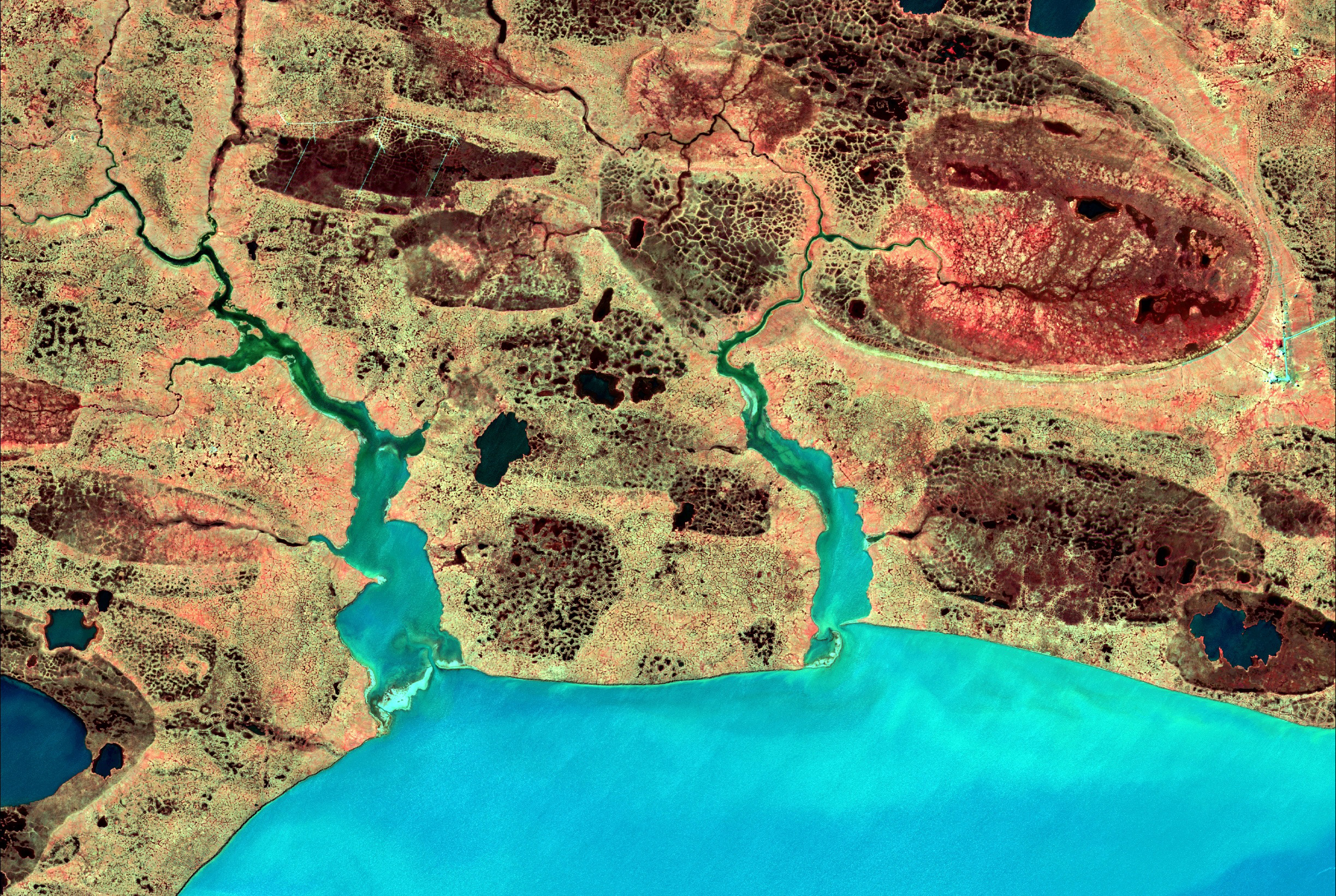As part of an international team, UConn remote sensing expert Chandi Witharana helps expand Permafrost Discovery Gateway

UConn researcher Chandi Witharana is using remote sensing as 'a virtual passport' to monitor vast expanses of land in remote areas, including the Arctic tundra. (Torre Jorgenson, University of Alaska-Fairbanks)
As the Arctic warms at nearly four times the global rate, permafrost - or ground that has remained below 0 degrees C for at least two consecutive years - that underlies much of the region is thawing rapidly, causing widespread ground collapse and infrastructure damage, threatening Arctic communities, and releasing carbon into the atmosphere.
This week, the Woodwell Climate Research Center announced $5 million in grant funding and a Fellowship from Google.org, the tech company's philanthropic arm, to support the development of a new, open-access resource that will use satellite data and artificial intelligence (AI) technology to make it possible to track Arctic permafrost thaw in near real-time for the first time. The research team includes Chandi Witharana, assistant professor in UConn's College of Agriculture, Health and Natural Resources.
To-date, real-time analysis of permafrost thaw has been out of reach due to the limitations of remote sensing and satellite imagery analysis. This new resource - an expansion of the Permafrost Discovery Gateway (PDG) - will use AI technology to streamline the data analysis process and make it easier to rapidly identify patterns and trends in permafrost thaw datasets that will be essential to informing climate mitigation and adaptation strategies.
"We will unlock the strengths of sub-meter resolution commercial satellite imagery and AI to create pan-Arctic scale geospatial map products of permafrost landforms, thaw disturbances, and human-built infrastructure" says Witharana, whose academic home is the Department of Natural Resources and the Environment.
The grant is being given to Woodwell Climate Research Center as part of Google.org's Impact Challenge on Climate Innovation, a $30M commitment to fund big bet projects that accelerate technological advances in climate information and action. In addition to funding support, Google.org will offer access to Google's products and the support of a Google.org Fellowship, a pro bono program that matches Google employees - engineers, user experience designers, program managers and more - with nonprofits and civic entities for technical projects, full time for up to six months.
"Timely tracking of permafrost thaw is critical to assessing impacts and informing action, but current limitations in technology, combined with the rapid pace of change in Arctic landscapes, have held us all back," says Anna Liljedahl, Woodwell Climate associate scientist and project lead. "This project will be groundbreaking in speeding up data analysis and unlocking completely new technological capabilities in how we do science in swiftly evolving landscapes, and, ultimately, what science itself can do."
"Nonprofits have told us that when they use AI, they're able to reach their goals in a third of the time and at half the cost," says Brigitte Hoyer Gosselink, director of product impact at Google.org. "The thawing of arctic permafrost is a timely issue the world needs to better understand so that we can take collective action. Google.org is proud to support Woodwell Climate Research Center and partners to conduct permafrost thaw analysis in near real-time; work that is now possible thanks to advanced technology like AI."
The three-year effort, being undertaken in partnership with University of Connecticut; National Center for Ecological Analysis and Synthesis, University of California Santa Barbara; National Center for Supercomputing Applications; Arizona State University; Alfred Wegener Institute; University of Alaska, Fairbanks; and Alaska Native Tribal Health Consortium, will focus on building automated workflows for geospatial product creation, AI models capable of identifying changes, patterns and trends, as well as environmental and climatic drivers, tera to petabyte scale permafrost thaw datasets.
In particular, the technology will enable scientists, decision makers, community members, and other interested groups and individuals to explore permafrost thaw features that formed during the previous month, check out seasonal forecasts of permafrost thaw, predict disturbance events based on weather forecasts, estimate carbon and infrastructure loss from abrupt permafrost thaw, and analyze the shape and size of permafrost thaw features and their patterns across the landscape over time. This resource will also be applicable beyond the scope of permafrost thaw, enabling experts to adapt this technology for other research areas and expand access to key climate data and actionable insights across a range of issues and regions of the world.
"We are excited to be working with Google.org to improve and extend the tools and data pipelines initially developed for the Permafrost Discovery Gateway (PDG) to new use cases. Closing the time gap between remote sensing data products becoming available and permafrost data products being published, such as the pan-Arctic sub-meter scale ice-wedge polygon dataset developed by Chandi Witharana and team, will hopefully help scientists and stakeholders better understand permafrost thawing at the pan-Arctic scale. We also hope to generalize some of the technologies and tools being developed so that more scientists can leverage this work to develop new permafrost related data pipelines," said Luigi Marini, lead research software engineer at the National Center for Supercomputing Applications (NCSA).
The effort will also collaborate with and provide more accurate, timely, and complete information to Permafrost Pathways, a major initiative also led by Woodwell Climate, funded through the TED Audacious Project and in partnership with the Arctic Initiative at Harvard Kennedy School and the Alaska Institute for Justice.
"This funding through Google.org will allow us to take permafrost carbon modeling to the next level by including abrupt thaw and integrating AI solutions into the estimations of permafrost carbon losses, enabling us to monitor threats to infrastructure in near-real time, estimate future risk, and inform planning to help us better respond to and prepare for permafrost hazards in Alaska communities and beyond" Liljedahl says.
Read the full release from Woodwell Climate Research Center.
This work relates to CAHNR's Strategic Vision area focused on Advancing Adaptation and Resilience in a Changing Climate.






